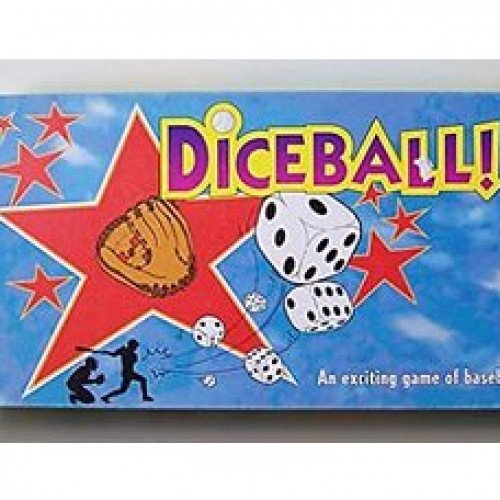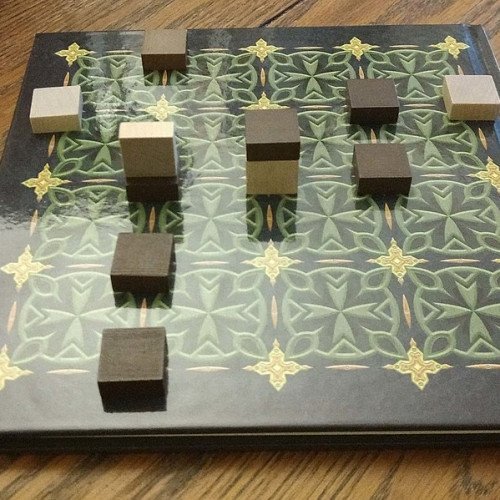DICEBALL VS TAK

DICEBALL
Diceball! is a board game in which two players roll dice to simulate a baseball game, one representing the visiting team and the other the home team. Both players use the dice to throw the baseball from the mound to the plate and field the ball on defense. Diceball! was designed to mirror the statistical reality of baseball. A regular game of Diceball! without extra innings lasts about 45 minutes. The game was designed in 1979 on a pizza box by a 16-year old Daniel Girard from Rawdon, Québec, while the Montreal Expos were chasing the pennant in the National League. Girard brought his game to his high school, where he organized tournaments with other students. Given the popularity of the game in his school, Girard also brought his game to university where it also became popular. The interest created by the game was noticed by entrepreneur Louis Desjardins, who launched the game with Girard. To start the game, the visiting team puts a pawn (as a batter and eventually runner) in the batter's box, to get the pitcher's throws. The die replaces the ball. The pitcher rolls the die until either the batter is struck out, the batter is walked, or the ball is hit. If the ball is hit, the offensive team rolls a die to determine the number of dice to be used to hit the ball. The number of dice indicated are rolled and added up. Numbers from 1 to 36 show the location where the ball is hit and the ball is placed on the game board. If the ball is hit on a circle, the ball was hit in the air and an out is recorded. If the ball is hit on a number in a cloud, it is a ground ball and that the batter will have to try to reach a base before the defense throws to that base. If the ball is hit to a star-shaped zone, the runner starts to run around the bases while the defence recovers the ball on the star. If the stars are from 27 to 36 it is a home run and all runners score. Every batter who runs around the bases and reaches home plate before three outs scores a run. As soon as three outs are recorded, stranded runners are removed from the bases. The teams trade places: the defense becomes the offense.
Statistics for this Xoptio

TAK
Tak is a two-player abstract strategy game designed by James Ernest and Patrick Rothfuss and published by Cheapass Games in 2016. The goal of Tak is to be the first to connect two opposite edges of the board with pieces called "stones", and create a road. To accomplish this, players take turns placing their own stones and building a road while blocking and capturing their opponent's stones to hinder their efforts at the same. A player "captures" a stone by stacking one of their pieces on top of the opponent's. These stacks can then be moved as a whole or broken up and moved across several spaces on the board. The vertical stacking and unstacking of stones gives a three dimensional element to the game play. A player may move a single piece or a stack of pieces they control. A stack is made when a player moves a stone on top of another flat stone of any color. The stone on top of a stack determines which player has control of that entire stack. All stones move orthogonally in a straight line on the board. There is no diagonal movement. A player can also move a whole stack in addition to single stones. A stack can be moved like a single stone, moved in its entirety one space orthogonally (North, South, East, or West), or it can move several spaces orthogonally by breaking the stack and placing one or more flat stones onto the squares being moved onto. The player can leave any number of stones, including zero, on the starting space, but must place at least one piece for each subsequent move. There is no height limit for stacks, but the amount of stones a player can remove from the stack and move is set by the "carry limit" of the board. The carry limit of the board is determined by the dimensions of the board. For example, if the stack was on a 5x5 board, the carry limit of the stack would be five. Because standing stones and capstones can't be stacked upon, there are no stacks with these pieces at the bottom or in the middle of the stack. Both of these stones however can be moved onto other flat stones to form a stack with them as the head. A capstone may "flatten" a standing stone and use it to form a stack with the capstone as its head, but it must do so alone. For example, a stack with a capstone cannot flatten a standing stone by moving as a stack onto the standing stone, but a stack can be used to move a capstone across the board so that the capstone alone moves to flatten the standing stone as the final movement.